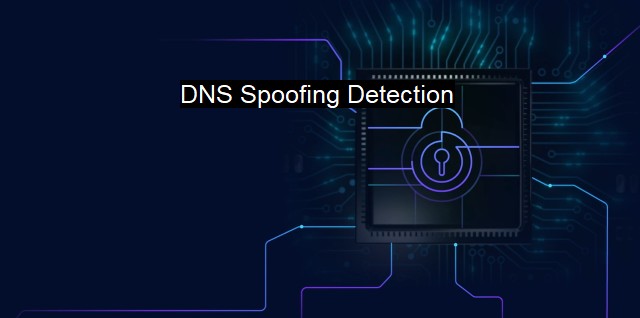What is DNS Spoofing Detection?
Crucial DNS Spoofing Detection Methods: Protecting Your Network from Cybersecurity Threats and Malware Attacks
To understand DNS Spoofing Detection, it is necessary first to familiarize with two prominent aspects of Internet functioning: the Domain Name System (DNS) and the problem DNS Spoofing represents.DNS is a fundamental part of the internet. Like a massive online phonebook, it translates the URLs we type into our browsers into IP addresses that computers can understand. It serves as the bridge between user-friendly domain names such as 'google.com' and the corresponding IP address, enabling users and computers to connect seamlessly to websites without memorizing arcane strings of numbers. DNS has been instrumental in scaling the Internet but, like any other system, it isn't impervious to its kinds of attacks. This vulnerability brings up the domain of DNS spoofing.
DNS Spoofing refers to an intentional action taken by malicious actors to redirect the internet traffic from legitimate servers to malicious ones, with the end user having minimal or no awareness of being victimized. DNS Spoofing, sometimes known as DNS cache poisoning or DNS redirection, is a formidable cybersecurity threat with potential ramifications being identity theft, financial loss, or severe disruption in web services.
The loophole these perpetrators prey upon is the trustee-reliance mechanism upon which DNS was initially built. In an original DNS query response exchange, there are minimal processes implemented to authenticate the source information provided, granting savvy cyber attackers the window for imposition. In DNS spoofing, the attacker intercepts the original DNS request and provides a counterfeit DNS response directing the user towards an IP of their preference- usually a malicious one.
To counter this emerging threat, cybersecurity professionals developed DNS Spoofing Detection techniques to help safeguard against these malicious practices. The idea behind this approach is to identify and alert anomalies in DNS response sources rapidly before any significant harm can occur.
DNS Spoofing Detection employs strategically positioned detectors that feed DNS servers with constant known queries. The responses from these servers are compared against pre-defined results that the queries ought to yield. If discrepancies emerge, implying a domain has been hijacked, alerts are immediately triggered.
A classical technique used for DNS Spoofing Detection is known as "DNSSEC" or Domain Name System Security Extensions. DNSSEC offers an avenue of authentication for DNS responses, enabling DNS servers to fact check IP response destinations to ensure they match the original sources. Doing so can prevent users from being misled onto hacker-predefined IPs, thus averting potential threats.
Antivirus software plays a crucial role in DNS Spoofing Detection by implementing additional layers of scans to alert any possible DNS anomalies or established connections to suspicious IP addresses. Antiviruses, in conjunction with firewalls, proactively thwart attempts of DNS forgery by the real-time monitoring of inbound and outbound data traffic, imposing additional barricades against DNS spoofing attempts.
Everyday efforts are made to enhance the precision of antivirus in deciphering DNS spoofing attempts. Machine Learning algorithms are employed to learn the patterns of legitimate and suspicious DNS responses. Artificial Intelligence (AI) also helps to asses critical threat levels faster and more accurately.
DNS Spoofing represents a significant threat to Internet users at large, from businesses to individuals, and Denting its reach and impact will continue to command considerable focus, skills, and resources of cybersecurity professionals. Across this combat zone, DNS Spoofing Detection has shown immense promise for securing and defending DNS-related transactions, effectively offering a more secure and reliable global internet.
While the challenge to secure the internet from DNS Spoofing is vast and continues to evolve, it is through DNS Spoofing Detection and heightened approach to cyberspace security that we can anticipate staying relatively safe from the potential grievances of these invisible cyber threats. With organizations and individuals, becoming more reliant on digital spaces, creating robust DNS security measures that includes an effective DNS Spoofing Detection protocol is not a premature concern, but a vital requirement.

DNS Spoofing Detection FAQs
What is DNS spoofing detection?
DNS spoofing detection refers to the process of identifying and preventing DNS spoofing attacks, which involve modifying the Domain Name System (DNS) to redirect users to malicious websites or intercept their online communications.How does DNS spoofing detection work?
DNS spoofing detection typically involves analyzing network traffic and DNS requests to detect abnormalities, such as inconsistencies in IP addresses or domain names. Some anti-virus and cybersecurity software also use behavioral analysis and machine learning algorithms to identify and block DNS spoofing attacks.Why is DNS spoofing detection important?
DNS spoofing attacks can compromise the security and privacy of users' online communications, as well as damage the reputation of legitimate websites that are targeted by such attacks. DNS spoofing detection is therefore important for protecting users from cyber threats and ensuring the integrity of the DNS system.What are some best practices for DNS spoofing detection?
To detect and prevent DNS spoofing attacks, users and organizations should ensure that they use secure DNS servers, keep their software and operating systems up-to-date with the latest security patches, and implement strong encryption and authentication mechanisms to protect their online communications. It is also recommended to use anti-virus and cybersecurity software that includes DNS spoofing detection capabilities.| | A | | | B | | | C | | | D | | | E | | | F | | | G | | | H | | | I | | | J | | | K | | | L | | | M | |
| | N | | | O | | | P | | | Q | | | R | | | S | | | T | | | U | | | V | | | W | | | X | | | Y | | | Z | |
| | 1 | | | 2 | | | 3 | | | 4 | | | 7 | | | 8 | | |||||||